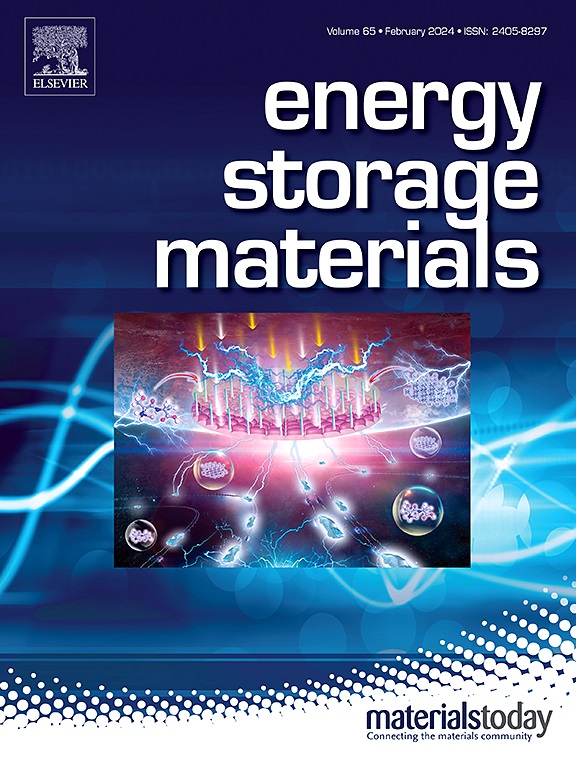Synergistic Regulation of De-solvation Effect and Planar Deposition via In-situ Interface Engineering for Ultra-Stable Dendrite-Free Zn-ion Batteries
IF 18.9
1区 材料科学
Q1 CHEMISTRY, PHYSICAL
引用次数: 0
Abstract
Advanced interfacial engineering is essential to address key challenges such as dendrite formation, parasitic reactions, and sluggish electrochemical kinetics, in aqueous zinc-ion batteries. In this study, by using a facile self-assembly method, we developed an armor-like interfacial layer (ZSL) on the Zn surface, serving as both an ion re-distributor and a protective barrier. This compact interfacial layer exhibits suitable hydrophilic and zincophilic features, enabling consistent and uniform Zn2+ flux and reducing voltage polarization. The ZSL also enhances the de-solvation process, speeds up zinc deposition kinetics, and suppresses parasitic reactions induced by water decomposition. Furthermore, it decreases the surface energy, promoting planar deposition of Zn2+. As a result, the modified zinc anodes demonstrate exceptional cycling stability, maintaining a dendrite-free surface for more than 8000 h with minimal byproduct formation. The asymmetric cell utilizing ZSL@Zn anodes exhibits highly stable reversibility over 6000 cycles with an average Coulombic efficiency (CE) of 99.89%. In full cells paired with Na2V6O16·3H2O (NVO) cathodes, the Zn-ion batteries exhibit excellent rate performance and long-term cycling durability. This work highlights the significant role of in-situ interfacial layers in achieving highly stable and reversible zinc anodes for large-scale zinc-ion battery applications.基于原位界面工程的超稳定无枝晶锌离子电池脱溶剂效应与平面沉积的协同调节
先进的界面工程对于解决水锌离子电池中的枝晶形成、寄生反应和缓慢的电化学动力学等关键挑战至关重要。在这项研究中,我们利用一种简单的自组装方法,在锌表面开发了一种类似盔甲的界面层(ZSL),它既是离子再分配器,也是保护屏障。这种致密的界面层具有良好的亲水性和亲锌性,使Zn2+通量一致、均匀,降低了电压极化。ZSL还增强了脱溶剂过程,加快了锌沉积动力学,抑制了由水分解引起的寄生反应。进一步降低了表面能,促进了Zn2+的平面沉积。因此,改性锌阳极表现出优异的循环稳定性,保持无枝晶表面超过8000小时,副产物形成最少。利用ZSL@Zn阳极的不对称电池在6000次循环中表现出高度稳定的可逆性,平均库仑效率(CE)为99.89%。在与Na2V6O16·3H2O (NVO)阴极配对的全电池中,锌离子电池表现出优异的倍率性能和长期循环耐久性。这项工作强调了原位界面层在实现大规模锌离子电池应用中高度稳定和可逆的锌阳极方面的重要作用。
本文章由计算机程序翻译,如有差异,请以英文原文为准。
求助全文
约1分钟内获得全文
求助全文
来源期刊

Energy Storage Materials
Materials Science-General Materials Science
CiteScore
33.00
自引率
5.90%
发文量
652
审稿时长
27 days
期刊介绍:
Energy Storage Materials is a global interdisciplinary journal dedicated to sharing scientific and technological advancements in materials and devices for advanced energy storage and related energy conversion, such as in metal-O2 batteries. The journal features comprehensive research articles, including full papers and short communications, as well as authoritative feature articles and reviews by leading experts in the field.
Energy Storage Materials covers a wide range of topics, including the synthesis, fabrication, structure, properties, performance, and technological applications of energy storage materials. Additionally, the journal explores strategies, policies, and developments in the field of energy storage materials and devices for sustainable energy.
Published papers are selected based on their scientific and technological significance, their ability to provide valuable new knowledge, and their relevance to the international research community.
 求助内容:
求助内容: 应助结果提醒方式:
应助结果提醒方式:


